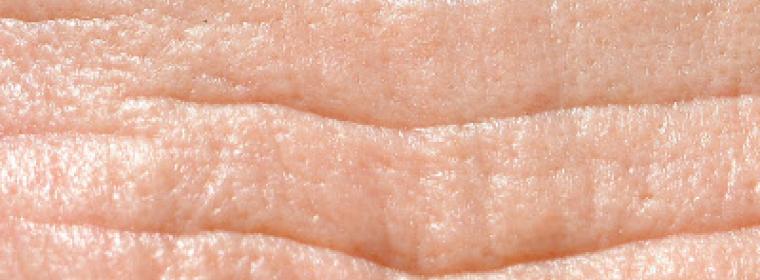
That little fold or crease in the outer corner of your eye, or on your forehead, or perhaps, falling from your nose towards the corners of your mouth. Interestingly enough, if you biopsy a wrinkle, and look at it under the microscope, the wrinkle is not evident. As a matter of fact, there is no anatomical structure associated with either a skin wrinkle or crease. And if you compare skin from a wrinkle with adjacent non-wrinkled skin, there is no histological difference seen in either a light microscope or an electron microscope.
So what is a wrinkle? Are wrinkles arbitrary? Are they a configurable change brought about by repeated muscular contractions? Are they influenced by environmental stressors like ultraviolet light or cigarette smoke?
The top layer of skin is called the epidermis. This layer gives the skin its waterproofing ability and protects the skin from environmental stressors like bacteria, viruses, allergens, and ultraviolet light. The second layer of skin is called the dermis. Within the dermis, specialized cells called fibroblasts produce the structural proteins, collagen and elastin, that give the skin its tensile strength and flexibility.
Under a light microscope, a breakdown in the elastic tissue within the dermis is seen in wrinkled skin. Deep wrinkles found in sun damaged skin show a disruption of the elastic tissue adjacent to the wrinkle in the lower levels of the dermis. These wrinkles seem permanent as one is unable to rid of them when stretching the skin. Wrinkles from sun protected skin, however, show a disruption of elastin in the superficial dermis. These wrinkles appear more temporary as one can 'erase' the wrinkles by stretching the skin.
Science has also shown that ultraviolet radiation from the sun, in particular UVB rays, can stimulate pro-inflammatory compounds. These compounds cause the collagen producing fibroblasts to express elastase, an enzyme that breaks down elastin yielding a loss of skin elasticity, and hence, wrinkle formation.
So what really causes wrinkles?
Many beauty and health magazines blame wrinkles on all sorts of things.
- Not washing your face.
- Not removing makeup before you go to sleep.
- Not sleeping on a silk pillowcase.
- Sleeping on your stomach instead of your back.
- Sitting too close to a computer screen.
- Resting your face in your hands.
There is very little, if any, science proving these allegations.
Based on science, no one really knows for sure what causes wrinkles but the scientific evidence points to:
- The effects of time itself, the unpreventable aging process, causes a decrease in function of skin cells that produce structural proteins, collagen and elastin. This yields superficial wrinkling.
- Ultraviolet exposure from the sun, a preventable form of skin aging, causes deeper wrinkling and a more permanent skin wrinkling due to the stimulation of the enzymes that break down healthy structural proteins necessary for healthy looking skin.
Commentary on wrinkles: Wrinkles are inevitable because they are a part of aging, and aging is inevitable. But aging is a process, a process not everyone gets to experience. Image if you knew 20 years ago what you know today. Embrace those wrinkles. You've earned them!
The best advice for healthy skin: live a healthy lifestyle. Eat a well-balanced nutritious diet, exercise regularly, get some zzz's, avoid direct sun exposure, especially midday, and wear a broad-spectrum sunscreen SPF 30+ daily!





